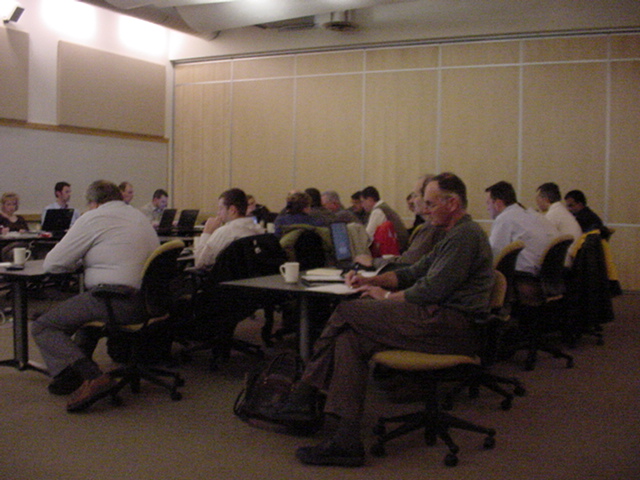Incremental wins at the PUC on Mesaba
July 9th, 2006
Now we’re going to see how uploading works on this puppy!
Why are these guys smiling? I’m not == uploading doesn’t work!
This was an utterly insane week, with Mesaba Discovery and Discovery issues flying and the Mesaba siting permit on the agenda of the PUC.
1) Order for Citizens Advisory Task Force
Thursday was the PUC meeting to accept the Mesaba siting application (siting of plant, transmission and natural gas) and decide whether they want to appoint a Citizens Advisory Task Force. Commerce staff had their opinion, found in Staff Briefing Papers — that there should NOT be a Citizens Advisory Task Force, and instead only be a “work group” of local government officials. SAY WHAT??? Read those Briefing Papers, it’s enough to make you puke… but remember, Commerce does not have the same charge as EQB, and the EQB was the one that utilized the statutorily authorized Citizens Advisory Task Force (CATF). As “Commerce” said, “we’re not bound by history.” As one representing the folks on the ground in these projects over the last decade, decade plus, color me outraged. OK, fine, that’s how you want to play it, I’m ready. Here’s my response to that attitude, a request for a CATF, because the statute says that when they get a request, they have to address it at the next meeting. Obviously, with their attitude, Commerce will just ignore that, so before they had time to talk their way around my request, they were flooded with 23 more!
Let’s see… we had mine to start, and I’ve been involved with three projects with four CATF’s; others from projects with CATFs who wrote were Shellene Johnson, former President of CRVC (Chisago Project), John Nauerth III who was on two CATFs in association with the SW MN 345kV line, Linda Hanson/WOLF, Intervenor in Arrowhead MN and WI; Julie Risser, candidate for SD 41 in Edina; Clean Water Action Alliance by Erin Jordahl-Redlin on behalf of its 60,000 members, Sierra Club Northstar Chapter by Christoopher Childs; Ross Hammond, P.E., formerly of Xcel (ran the Riverside coal plant!) and NRG and who is now an ME3 Board Member; Harold Dziuk, DVM, Ph.D., who was a member of the PUC’s Science Advisors regarding ground currents; and locals on the ground including Earl Orf, Ron Gustafson, Charlotte Neigh, Esq., Jane Latimer, Andrew David, Linda Castagneri, Kurt Christopherson, Brad Jones, Darrell and Dee White, David and Carmen Griggs, Doug and Barbara Veit, Thomas Nelson and Sanna Pederson, and last but certainly not least, Bob and Leeann Norgord.
Yes, the PUC got the message allright, and Ordered a Citizens Advisory Task Force. But what was very disturbing was the Commerce attitude that there were plenty of opportunities to participate, there were all these public meetings and there would be even more. What a load of crap (which barely begins to express my disgust)! There has been exactly one public meeting in the past year since the West Site was revealed as Excelsior’s preferred site. That was the DOE meeting for the DOE’s EIS. Check out the transcript for a sense of the public outrage about this “West Site.” Nothing from the state, no public meeting at all yet, and 8/22 is the Siting informational meeting. In the PPA docket, they hadn’t anticipated doing meetings up north (EH?) and the latest is the ALJ thinks that the public should not be able to cross-examine witnesses up there. EH???? So anyway, we got an Order for a Citizens Advisory Task Force.
2) Order for access to Trade Secret Information
And now back to the Mesaba PPA docket, where we’ve been having a pissing contest over access to cost information in a PPA docket — a Power Purchase Agreement is about nothing but cost — but the ALJ said pre-emptively and prematurely and without specific determinations, that mncoalgasplant.com was not entitled to cost information. Really! Here’s from the memorandum:
Parties that are not a utility or a power producer will usually not need access to the detailed cost and technical data. Sometimes they are not in a position to make helpful comment about it. But they may be. So separate treatment is reasonable…
And the separate treatment we got was a paragraph that was NOT in the Protective Order drafts we discussed at the PUC Hearing, those were just fine, this is patently offensive:
(F) Non-utility or non-power producer Parties shall not have access to Trade Secret Information absent a showing that the interest they seek to protect reasonably requires it.
So, what, we guess what might be there and try to prove we need something when we don’t know what it is? Right…
We got support from the Xcel Industrial Intervenors (Geraud Ameristeel and Marathon Oil) in their brief. …sigh… how to upload a pdf? grrrrrrrrrrrr
And the PUC site is screwed up and the OAH site doesn’t list anything, WTF? So I guess that won’t get posted…
Anyway, we got the Order in the afternoon, after the PUC hearing on the siting side of the project, and it said:
(3) However, pursuant to subparagraph 1(c)(ii)(F) of the Protective Order, MCGP has shown that the interest MCGP seeks to protect in thos proceeding reasonably requires access to Trade Secret Information, as defined in the Protective Order; and (4) MCGP is therefore GRANTED access to Trade Secret Information, as defined in the Protective Order.
3) PUC issues notice of Comment Period — Just a day after the meeting, an email goes out to the service list on the PPA docket that they’re taking Comments on Cost issues. GOOD!
NOTICE OF COMMENT PERIOD ON WHETHER THE COMMISSION SHOULD SPECIFY ADDITIONAL ISSUES TO BE ADDRESSED At its July 6, 2006 agenda meeting, the Minnesota Public Utilities Commission (Commission) considered the acceptance of Excelsior Energy Inc.â??s (Excelsior) Combined Application for a Site Permit, Transmission Line Route Permit, and Natural Gas Pipeline Permit for its Mesaba Energy Project in Docket No. E-6472/GS-06-668. In the course of discussions on the 06-668 docket, issues were raised that may be more directly addressed in Docket No. E-6472/M-05-1993 (05-1993 Docket) which the Commission has already referred for contested case hearing. The Commission directed its staff to bring these issues back before the Commission at a future agenda meeting in the 05-1993 Docket. Written comments will be accepted on whether the Commission should supplement its April 26, 2006 Notice and Order for Hearing and Order Granting Intervention Petition in the 05-1993 Docket to request that parties specifically address:-the costs of transmission upgrades and related facilities beyond the substation associated with the Mesaba Energy Project; and-the costs of other infrastructure investments associated with the Mesaba Energy Project.Parties wishing to comment shall do so by 4:30 p.m. on July 18, 2006 This matter is tentatively scheduled to be heard at the Commissionâ??s July 27, 2006 agenda meeting.Questions regarding this matter may be directed to Janet Gonzalez at 651-201-2231.
CUB says Arrowhead transmission design is flawed
May 18th, 2006
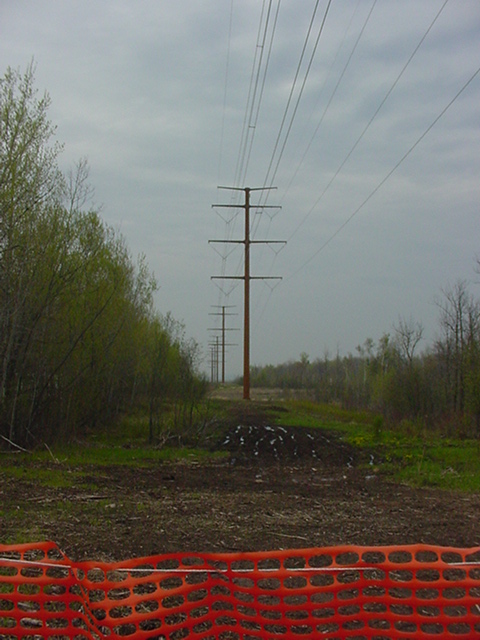
Citizens Utility Board has filed with WI’s Public Service Commission, saying the design of the Arrowhead-Weston Transmission Line is flawed. Yeah… your point???
From today’s St.PPP:
Group alleges flaws in powerline
But transmission company says complaint is old, has no meritAssociated Press
MADISON â?? A utility watchdog group asked state regulators Tuesday to investigate what it says are serious flaws in the design of a high-voltage transmission line under construction between Wausau and Duluth, Minn.
In a worst-case scenario, a failure with the line could lead to a cascade of outages and possible damage to power plants, said Charlie Higley, executive director of the Citizens Utility Board.
But Mark Williamson, vice president of Pewaukee-based American Transmission Co., said the group’s concerns are unfounded and based on a “flawed” analysis that already has been investigated.
American Transmission will own and operate the $420 million line, being built by Wisconsin Public Service Corp., when it is brought into service in 2008.
In a letter delivered to each company, the citizens’ group said engineering mistakes mean the 345-kilovolt Arrowhead-Weston power line is undersized in capacity.
“The Arrowhead line will likely not work when it’s most needed,” Higley said. “And that’s when it’s helping support other transmission lines in the region while power is flowing heavily. That’s when the line is most vulnerable.”
Linda Barth, a spokeswoman for the state Public Service Commission, said the regulatory agency is looking at the issues raised in the group’s letter.
“But that said, this line has been approved twice and we’re confident in the exhaustive process we used in approving the Arrowhead-Weston line,” she said. “It was a sound and thorough decision.”
The Citizens Utility Board raised its concerns following an in-depth analysis by Larry Thiele, an independent consulting electrical engineer. The board hired Thiele in 2003 to provide expert testimony regarding the line’s design.
Thiele’s analysis concluded the line would fail if an outage occurred on the King-Eau Claire-Arpin transmission line, the only high-capacity line connecting Wisconsin directly to Minnesota. The failure would cause transmission lines to carry too much power and could damage power plants and lead to blackouts, Thiele concluded.
Williamson said those concerns had already been investigated and dismissed.
“This is the third time that the same complaint has been raised and there’s just no merit to it,” he said.
He said the purpose of the Arrowhead line was to strengthen the system by providing redundancy and protection for the power grid â?? solving the very problems Thiele says would threaten it.
Here’s the CUB Request for Investigation: Download file
Essentially, they’re saying that the Arrowhead line is unstable because the capacity is too low. But it seems to me they’re not taking into account the old news of the EQB’s design requirement of a capacity limitation of 800MVA through the phase shifting transformer. Here’s the MPCA Commissioner’s Memorandum to the EQB that resulted in the limitation: Download file
Mesaba Interconnection
Through all of this though, no one’s paying any attention to the impact of Mesaba on Arrowhead. Originally they were planning on connecting to Blackberry and from there going to the Forbes sub and out over Arrowhead — thankfully that is not now in the plans (it seems). Now it’s going from Blackberry to the Riverton sub. The MISO interconnection study, G519, has just been released:
MISO System Interconnection Study G519
The Conclusion of the study states that:
Under high off peak transfer conditions G519 aggravates voltage problems at 230kV, 161kV and 115kV buses around Arrowhead and Stone Lake. (Ch. 7, p. 7-1)
Going to the horse’s mouth, it says:
Transient voltage violations are attributed to the G51 project. HOwever, Table 5-2 shows that in the G519 study model the Forbes-Chisago 500kV line (F601C) is overloaded and Arrowhead-Weston is loaded above its expected operating limit of 650MW. Sensitivity analysis, presented in Section 6, was performed to verify the potential constraints with flows on F601C and Arrowhead-Weston within limits. (Ch. 5, p. 5-7)
The MISO study found that the connection of Mesaba adds to stability problems, and the modeling assumes the line is operating at above the stated capacity, above the limits, but below the phase shifting transformer limits.
More on what it means for Mesaba, but the bottom line is that Excelsior will have to have “someone” (because heaving forbid they would be responsible for their own infrastructure) make the following associated transmission system upgrades:
1) Add new 230kV line from Boswell to Riverton
2) New 230kV bus position for Boswell-Riverton line at Boswell
3) New 230kV bus position for Boswell-riverton line at Riverton
4) New 230kV subsation at Hill City
5) Replace 4 115kV circuit breakers at Nashwauk
Corresponding costs:
1) $45 million
2) $1.9 million
3) $1.7 million
4) $3.5 million
5) $720,000
TOTAL NECESSARY MESABA UPGRADES: $52.82 million
And remember, this does not include the direct interconnection costs from the plant to the Blackberry sub… and I think those costs are grossly underestimated.
Lots more on this topic later!
Transmission comes to Red Wing
April 4th, 2006
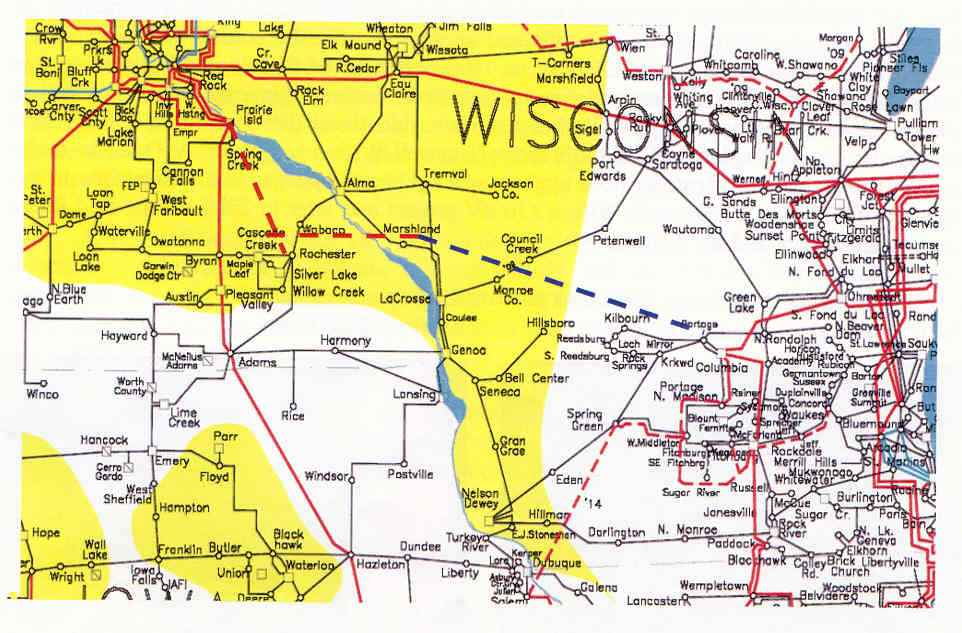
I spent some time a couple weeks ago looking at how transmission comes into and out of Prairie Island, and finally got some pictures today — taking a sick day and have to justify my existence, and a good thing to finally check out this route given we’ve got three lines planned in the area, in order of likely appearance:
1) SW MN to Prairie Island (but maybe Hampton)
2) Prairie Island to Rochester to LaCrosse
3) Chisago County sub to Red Rock to Prairie Island
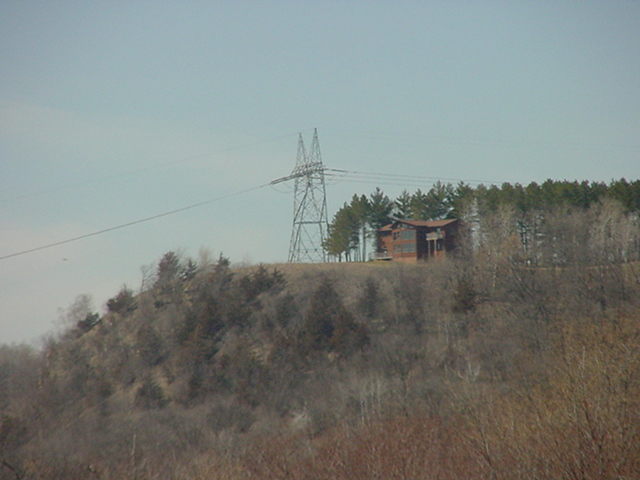
This is that house on the bluff, beautiful house and beautiful view, as long as you don’t look to the immediate west and see the 345kV line that is just on the other side of a tree line. And of course that’s the Prairie Island – Byron line, the one that the PI-Roch-LaX will probably share a corridor with up and over the bluffs. And what are they doing up there? Well, that homeowner is selling the house! And they’re putting in the “Westwood” subdivision up there, right next to the transmission line. The lots they’re selling are in the right, under the transmission and to the right. Half of the homes have driveways under the line. Here’s a plat of the project, and I was standing for this photo at the bulbous blip down near the bottom. See how the line goes through all the lots on the right side?
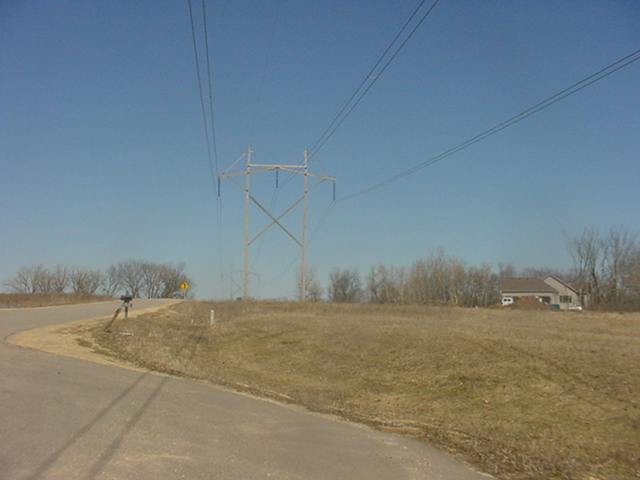
If they run another line with this one, where is it going to go? There’s nowhere else but on the right hand side, closer to the houses on that side…
I’ve left messages for the two realtors/developers up there, and the City Planner, no response yet.
Here is the link to the 2005 Transmission Plan that lists the PI lines on p. 36-38. The Prairie Island-Roch-LaX line application is expected 1st quarter 2006 (these things are usually delayed a bit),
Here is the site for the Minnesota Transmission Owners
And here is the section of the report with p. 36-38
Attached is a Download file“>Sept. 6, 2005, letter from CapX2020 giving a quick rundown of these projects, again, this is the Prairie Island-Roch-LaX line that goes over your development up on the bluff right by 61. It’s listed on the bottom of p. 2 in a chart, and on p. 6 is the map.

Look close to the house on the right-hand side for the 345kV line.
In MN, there’s the PEER “non-proliferation” theory, and usually new transmission follows existing transmission corridors, and so this will probably follow the PI-Byron line (the existing one up there). However, to build it, it would require additional easement alongside that line. I’d guess that’s a problem!
Here’s their plat with my “artiste’s conception” of transmission route:

There was meeting about this held in Rochester, at Rochester Public Utilities, info on that meeting is on the www.minnelectrans.com site. They must under the rules provide notification to the affected cities, counties and townships, but no city, county, or township officials ever show up at the meetings and probably haven’t a clue this is coming up. …sigh… and they’re building new, very expensive homes up there…
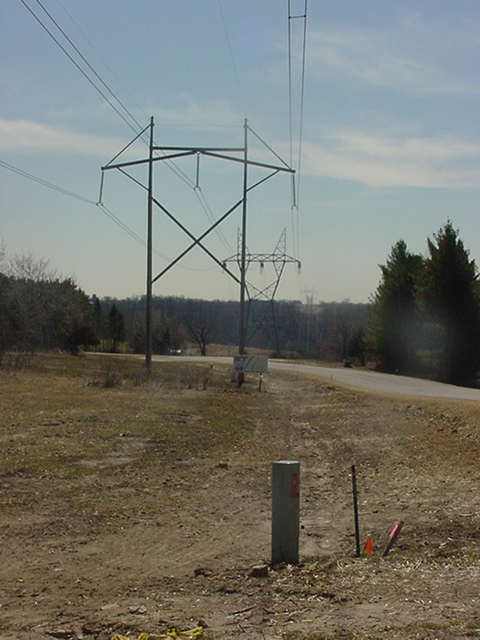
Corruption in the extreme
December 8th, 2005
Lately, I’ve been thinking of deals and lies and extortion and greed and deals and lies and scams and blackmail and deals and lies in the public arena, supposedly for the public good. Yeah, right… And I was also thinking of the former Mayor of St. Croix Falls, and Loren Jennings, formerly Representative and now felon, as I blew past Harris, the Chisago area, on the way up North this week, wondering in the very, very large sense what all we don’t know about what goes on in the name of “public interest,” what goofy schemes are called “public policy” and where that leaves us… My guess is that most of us would be suprised at what all is for sale and how low the price.
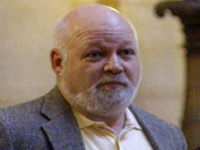
Stolen from www.kstp.com
Here’s news in the St.PPP of another corrupt official, former Wisconsin state Senator Chuck Chvala, another one with utility ties:

Stolen from Milwaukee Journal Sentinal Online
Here’s some context from Milwaukee’s Journal Sentinal:

One of my favorite books is Sissela Bok‘s “Lying,” and of course “Secrets.” Lying has a powerful section on instutional lying, the kind of things people tell themselves when they’re involved in utterly immoral activity, palliatives for politicians’ guilty conscience. And the impacts are broad:
… citizens the world over have less confidence that they can influence what governments do.
The loss in confidence benefits individuals to an externt. Those in a position to resist oppression by bureaucracies will do so, and fewer can be talked into fighting senseless wars. But the major effects are surely negative. For insofar as problems have to be met jointly — problems, for example of disarmament, energy, or population — the fact that government information cannot be trusted is crippling. Bona fide efforts in the joint interest are thus undercut by the cynicism and sense of powerlessness which result from the knowledge of large-scale decpetion.
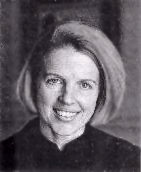
If we assume the perspective of the deceived — those who experience the consequences of government deception — such arguments are not pursuasive. We cannot take for granted either the altruism or the good judgment of those who lie to us, no matter how much they intend to benefit us. We have learned that much deceit for private gain masquerades as being in the public interest. We know how deception, even for the most unselfish motive, corrupts and spreads. And we have lived through the consequences of lies told for what were believed to be noble purposes.
Lying, p. 144,169 (emphasis added)

MAPP NM-SPG = Transmission
November 30th, 2005
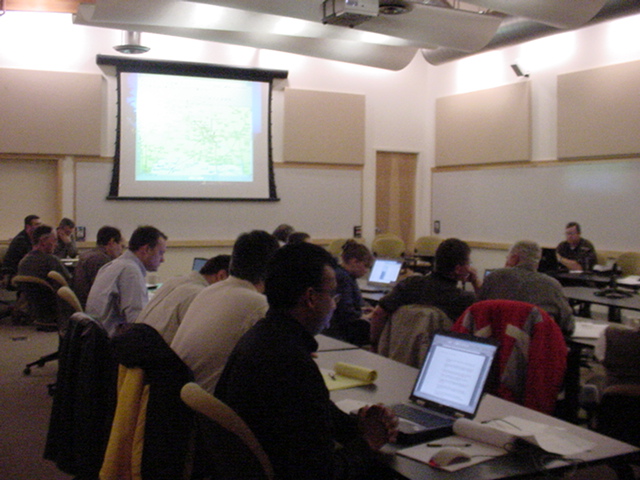
Today was the MAPP SPG meeting, I guess it’s technically MISO now, but everyone calls it MAPP. This is where it’s decided how to make the wishes of those with the power happen. There is a distinction between the policy promotion of transmission , i.e., whether we’ll have distributed and dispersed generation or central station power, and the technical problems such as overloads, impacts of connecting generation on the system as a whole. This group deals with the technical problems, calling them to the group’s attention and banding together to figure out a fix. In this respect, it is all connected. But because it’s all connected, this is also the venue where the policy doesn’t always agree with the laws of physics, yet engineering brains are trying to make it happen, yielding occasional “OH SHIT!” moments!
For example, today we talked about the “northern loop” problem, which is the 10% or so of the Buffalo Ridge wind energy that is shooting up to Dorsey, Montana, then over to the Forbes substation, and then down to the Chisago sub — by that time, given line losses, there’s probably nothing left! Here’s what the report says:
… it is observed that whatever transmission Option were implemented, approximately 4-5% of the SW Minnesota –> Twin Cities/Milwaukee power delivery flows northward to Manitoba on the Rugby-Glenboro and Letellier-Drayton 230kV lines, and then southward on the Dorsey (Riel) Roseau Co-Forbes-Chisago Co 500kV.
It’s 200MW over limits and gets worse as the level of export from North Dakota goes up. What to do? Well, they don’t quite know yet, but here’s what they’re looking at:
* Phase Shifting Transformers — VERY EXPENSIVE – $5-8 million
* Lower impedence of new 345kV line – solves problem by directing more electricity through 345kV line because more here = less there, and also decreases line losses on 345kV (no cost provided)
* Increase 500kV loadability – with capacitors, the rating could be increased over 400 MVA — also $5-8 million
This Manitoba wind problem is a good example of why it’s not very bright to be shipping electricity over long distances — there are so many variables to account for, and where we’re dealing with a generation source with a 41% capacity factor, and assuming at least 30% line losses before it gets to where it’s going, if everything goes right, this is about the least efficient and most wasteful way to supply electricity.
Here’s another example, imagine Mesaba, cranking away producing electricity. They put it on the line, and it goes out into the world toward a “sink” end point, and guess what?
The transfer analyusis indicated that, excluding pre-existing constraints, the proposed facilities would be limited to less than 90 MW in deliveries to Xcel Energy for the indicated sinks.
Translation – they’re sunk – they can’t get the power to the sink! To find this glorious sentence, go to the MISO queue and scroll down to project number 38280-01, the Mesaba project, and then scroll way right and click on X2.
Watching paint dry? I think not!
